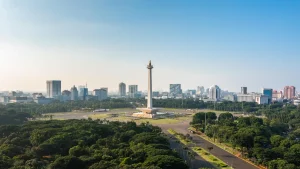Table of Contents
AMDAL is a key document in Indonesia to ensure that business plans or activities do not cause damage that is detrimental to the community and future generations.
AMDAL plays a vital role as a guide so that every project, from small to large scale, remains in line with the commitment to preserve nature.
Let’s take a look at the following information to understand the objectives, types, and benefits of AMDAL in supporting environmentally friendly and sustainable development.
What Is AMDAL?
AMDAL stands for Analisis Mengenai Dampak Lingkungan, also known as EIA in English, which stands for Environmental Impact Assessment. This study examines the significant impacts that a business plan or activity may have on the surrounding environment.
According to Government Regulation No. 27 of 1999 concerning Environmental Impact Assessment, AMDAL is part of the decision-making process on whether a project can be implemented, taking into account its environmental impact.
The AMDAL document consists of the following components:
- KA-ANDAL (Kerangka Acuan Analisis Dampak Lingkungan or Term of Reference of Environmental Impact Assessment).
- ANDAL (Analisis Dampak Lingkungan or Environmental Impact Analysis).
- RKL (Rencana Pengelolaan Lingkungan or Environmental Management Plan).
- RPL (Rencana Pemantauan Lingkungan or Environmental Monitoring Plan).
Objectives of AMDAL

AMDAL serves an essential purpose as a guideline for environmentally friendly and sustainable development. The general purpose of AMDAL is to maintain a balance between development needs and the preservation of the earth so that human-made disasters can be avoided.
The following are details of the objectives of AMDAL in various aspects:
- To prove the responsibility of environmental preservation for future generations.
- To ensure that the quality of the environment is maintained to remain livable.
- To prevent negative impacts that could threaten the health and safety of the people.
- To maintain the balance between the use of natural resources and the population in the local area.
- To encourage the use of renewable and recyclable resources.
- Providing feedback for business or development planning helps companies and governments make wiser decisions.
- Serving as a guideline for the prevention, management, and monitoring of environmental impacts.
- Providing a basis for licensing businesses or activities that meet environmental requirements.
- Documenting data and information that can be used for regional development planning.
Read also: 7 Advantages of Biopori for the Environment You Must Know
Types of AMDAL

After understanding the objectives of AMDAL, it is also essential to recognize its various types. Each type is tailored to the scale, nature, and scope of the project, so the approach differs. Here are five main kinds of AMDAL and their examples:
1. Single AMDAL
A Single AMDAL is an environmental impact assessment for a single activity or project under the supervision of one supervisory institution. Such projects usually have a clear and focused scope.
For example, the construction of a hospital, a power plant (PLTU), or an office building. With only one responsible institution, the preparation and evaluation process is relatively more straightforward than other types of processes.
2. Sectoral AMDAL
This type is carried out for projects managed by ministries or institutions according to their fields. The relevant sectoral minister approves the study.
For example, the construction of toll roads, ports, or airports requires coordination between institutions in the transportation sector. The sectoral approach ensures that the standards and regulations of each industry are met.
3. Social AMDAL
Social AMDAL is intended for activities that focus on the social interests of the community. This assessment usually involves more than one social institution because its scope is related to public needs.
Common examples of its application are the construction of schools, community health centers, or public facilities in densely populated areas. This AMDAL emphasizes environmental protection as well as improving the welfare of citizens.
4. Regional AMDAL
Regional AMDAL is used for projects with significant impacts that cross administrative boundaries, such as between districts or cities. Its scope is broader and requires coordination between many parties.
Examples of such projects include large-scale mangrove planting, industrial area development, or dam construction that affects several areas at once.
5. Integrated AMDAL
The Integrated AMDAL type assesses projects that involve multiple sectors and have significant interrelated impacts. Due to its complexity, this assessment requires cross-disciplinary and institutional analysis.
Examples of integrated AMDAL projects include the development of large settlements that include industrial areas, factories, and other supporting infrastructure.
Read also: UKL-UPL: Definition, Benefits, and Differences Between AMDAL
Benefits of AMDAL in Various Aspects

AMDAL provides tangible benefits for all parties involved in development, from the government, capital owners, business actors, and the community. Check out the following explanation:
1. For the Government
One of the benefits of AMDAL for the government is that it helps prevent pollution and environmental destruction while ensuring that every project runs in accordance with the principles of sustainable development.
AMDAL is also a manifestation of the government’s responsibility in environmental management, minimizing conflicts with the community, and serving as the basis for licensing policies.
2. For Capital Owners or Investors
The results of the AMDAL assessment are an essential reference for financial institutions or investors before providing loans or financial support.
Projects with precise and high-quality AMDAL demonstrate a commitment to sustainability, thereby reducing the risk of long-term losses due to business entities mismanaging their operations in violation of environmental sustainability regulations.
3. For Project Owners or Entrepreneurs
AMDAL ensures that business activities comply with environmental laws and regulations, while reducing the risk of lawsuits or sanctions. This assessment also supports good relations with the surrounding community and improves the company’s image in the public’s perspective.
For initiators, AMDAL serves as a guide for managing and monitoring environmental impacts from the earliest stages of planning through to operations.
4. For the Community
AMDAL also benefits the wider community. The public can obtain information early on about development plans and their potential impacts.
This allows them to be involved in the decision-making process, monitor project progress, and provide feedback to protect the environment. AMDAL also provides a sense of security by supporting a mechanism that controls negative impacts on the environment.
In essence, AMDAL is a crucial foundation for maintaining the balance of nature while supporting sustainable development. By implementing AMDAL, any risks of pollution from business activities and environmental damage that could harm many parties can be prevented.
You can also play a role by supporting the implementation of environmental studies in your area, for example, by providing suggestions when there are development projects or spreading information about the importance of AMDAL.
Simple steps like this help the government, businesses, and the community maintain the quality of the environment so that it stays protected for future generations.
In line with this spirit, you can join the #AksiAsri movement from Indonesia Asri to raise awareness about environmental conservation, from sorting waste and reducing single-use plastics to supporting AMDAL programs in your area.
So, what are you waiting for? Register now, be part of the change through #AksiAsri, and support the implementation of AMDAL so that development goes hand in hand with nature conservation.
Read also: Understanding the Effects of Acid Rain on the Environment









